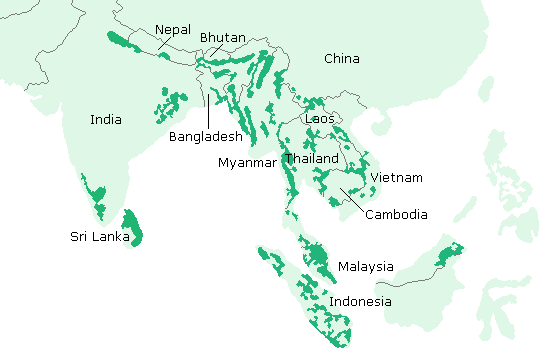Endangered Species - Indian Elephant

About
Indian elephants (Elephas maximus indicus) are one of the largest walking animals on Earth, weighing about 5 tons and can grow up to 11 feet tall. These elephants spend a lot of time near sources of fresh water as they need to drink at least once per day along with eating close to 19 hours per day. They like to eat grass, tree bark, bananas, rice, and sugarcane. The result of all this food consumption is the production of 220 pounds of dung everyday!
Habitat

The Indian elephant mainly lives in South-East Asia. Countries include: Bangladesh, China, Cambodia, Nepal, Pakistan. They thrive in grasslands and forests.
Role in Ecosystem
Indian elephants help maintain the integrity of the forest and grassland habitats of South-East Asia. They can travel several hundred miles per day which helps with germination and cultivation of seeds.
Why are they disappearing?
The rapidly increasing population in Southeast Asia is causing homes being built in the habitats of these elephants. The species is being constrained to tight areas that aren't able to sustain their size or their need to roam. Also, the males are being hunted for their ivory tusks, skewing the sex ration which is drastically throwing off breeding rates for the species.
Why is this important?
Elephants are a keystone species, if they were to disappear, there would be devastating impact throughout the ecosystem. Indian elephants knock down trees, so without them, forests would overtake the grasslands resulting in the endangerment of several grassland species. Also, these elephants dig watering holes that many species throughout the ecosystem depend on. Without these watering holes, many species would have no source of water and could go extinct.
What is being done?
There are elephants sanctuaries in the foothills of the Himalayas that over 1000 square miles where elephants can roam while being protected. There are efforts to train and educate locals to monitor and take care of Indian elephants to ensure they are healthy. There have been international trade bans on ivory which has reduced the demand.
What can I do to help?
There are several ways that you can help slow the declining population of Indian Elephants. Don't buy ivory, the best way to decrease demand is to not buy it at all. You can buy fair trade coffee and wood, look for FSC certified timber and certified free trade coffee. Circuses and zoos can often look like they are helping elephants but are actually harming them by not providing enough food or space fo them to live. Boycotting such attractions can help elephants. Lastly, you can adopt an elephant or give to the elephant conservation efforts: the world wildlife foundation and many others allow you to "adopt" an elephant and they will take care of them for you. Links can be found below.
- https://elephantconservation.org
- https://donate.wwf.org.au/adopt/elephant#gs.67req0
Sources:
https://www.mnn.com/earth-matters/animals/stories/6-ways-to-help-elephants
https://www.worldwildlife.org/species/indian-elephant
https://www.nationalgeographic.com/animals/mammals/a/asian-elephant/
Comments
Post a Comment